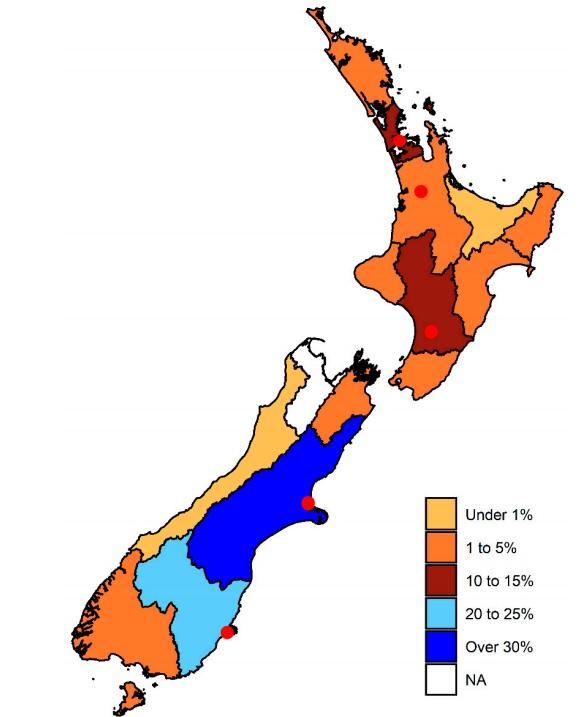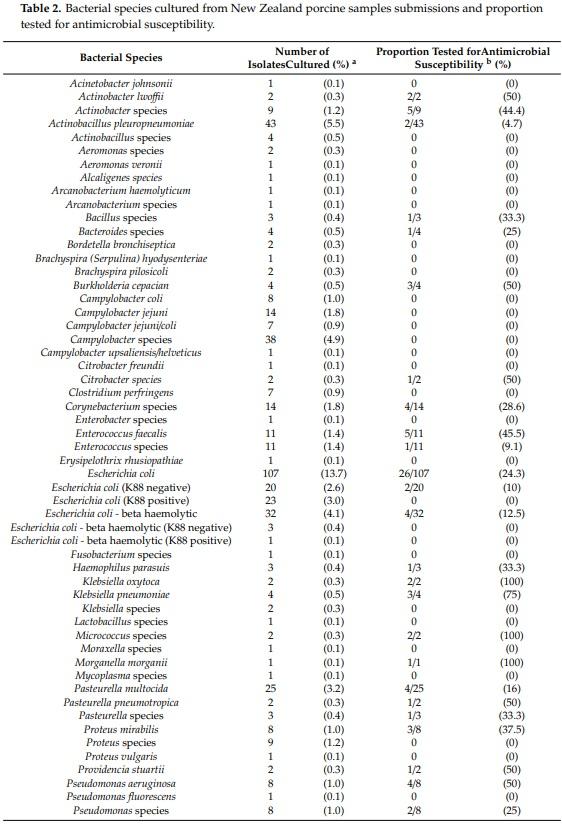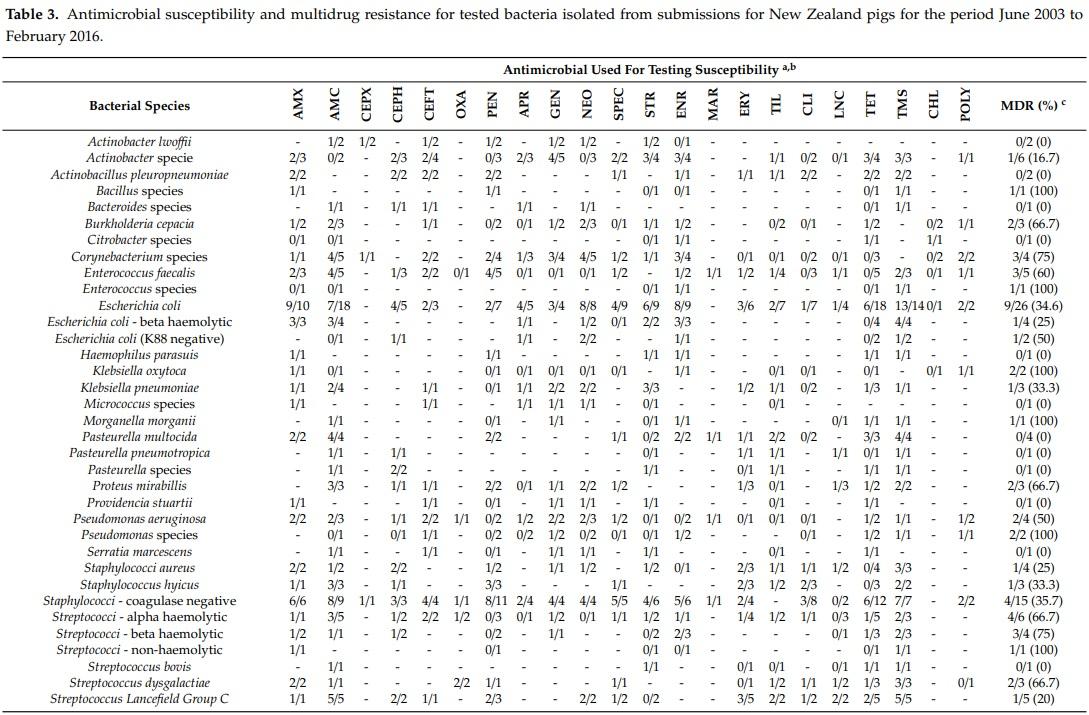Isolates, Antimicrobial Susceptibility Profiles and Multidrug Resistance of Bacteria Cultured from Pig Submissions in New Zealand
Data on the bacterial pathogens and the frequency of antimicrobial resistance (AMR) in New Zealand’s pork industry are limited. This study describes bacterial isolates, antimicrobial susceptibility data, and multidrug resistance (MDR; resistance to ≥3 antimicrobial classes) from New Zealand pig submissions. Porcine bacterial culture test results from June 2003 to February 2016 were obtained from commercial veterinary pathology laboratory records. In total, 470/477 unique submissions resulted in bacterial growth, yielding 779 isolates. Sample type was recorded for 75.5%; lung (21.9%), faecal (16.9%) and intestinal (12.5%) were most common. The most common isolates were Escherichia coli (23.9%), Actinobacillus pleuropneumoniae (5.5%), Streptococcus suis (5.5%), unidentified Campylobacter spp. (4.9%), alpha hemolytic Streptococci (4.1%), coagulase negative Staphylococcus spp. (3.3%), and Pasteurella multocida (3.2%). Susceptibility results were available for 141/779 (18.1%) isolates from 62/470 (13.2%) submissions. Most were susceptible to trimethoprim-sulphonamide (92.6%), but fewer were susceptible to penicillin (48.1%), tilmicosin (41.9%), or tetracyclines (36.0%). No susceptibility data were for available Salmonella spp., Campylobacter spp., or Yersinia spp. isolates. MDR occurred in 42.6% of tested isolates. Data on sample submission drivers, antimicrobial drug use, and susceptibilities of important porcine bacterial isolates are required to inform guidelines for prudent antimicrobial use, to reduce their prevalence and MDR.
Abstract: Data on the scope of bacterial pathogens present and the frequency of antimicrobial resistance (AMR) in New Zealand’s pigs are limited. This study describes bacterial isolates, antimicrobial susceptibility data, and multidrug resistance (MDR; resistance to ≥3 antimicrobial classes) from New Zealand pig submissions. Porcine test data from June 2003 to February 2016 were obtained from commercial veterinary pathology laboratory records. In total, 470/477 unique submissions resulted in bacterial growth, yielding 779 isolates. Sample type was recorded for 360/477 (75.5%); lung (79/360; 21.9%), faecal (61/360; 16.9%) and intestinal (45/360; 12.5%) were most common. The most common isolates were Escherichia coli (186/779, 23.9%), Actinobacillus pleuropneumoniae (43/779; 5.5%), Streptococcus suis (43/779; 5.5%), unidentified Campylobacter spp. (38/779; 4.9%), alpha haemolytic Streptococci (32/779; 4.1%), coagulase negative Staphylococcus spp. (26/779; 3.3%), and Pasteurella multocida (25/779; 3.2%). Susceptibility results were available for 141/779 (18.1%) isolates from 62/470 (13.2%) submissions. Most were susceptible to trimethoprim-sulphonamide (75/81; 92.6%), but fewer were susceptible to penicillin (37/77; 48.1%), tilmicosin (18/43; 41.9%), or tetracyclines (41/114; 36.0%). No susceptibility data were available for Salmonella spp., Campylobacter spp., or Yersinia spp. isolates. MDR was present in 60/141 (42.6%) isolates. More data on sample submission drivers, antimicrobial drug use, and susceptibilities of important porcine bacterial isolates are required to inform guidelines for prudent antimicrobial use, to reduce their prevalence, human transmission, and to minimise AMR and MDR.
Keywords: antimicrobial; resistance; multidrug; bacteria; susceptibility; pig; pork; porcine.



1. Abatih, E.N.; Ersbøll, A.K.; Lo Fo Wong, D.M.A.; Emborg, H.D. Space-time clustering of ampicillin resistant
Escherichia coli isolated from Danish pigs at slaughter between 1997 and 2005. Prev. Vet. Med. 2009, 89,
90–101. [CrossRef]
2. Heffernan, H.; Wong, T.L.; Lindsay, J.; Bowen, B.; Woodhouse, R. A Baseline Survey of Antimicrobial Resistance in
Bacteria from Selected New Zealand Foods; 2009–2010 MAF Technical Paper No: 2011/53; Ministry of Agriculture and Forestry: Christchurch, New Zealand, 2011.
3. Stärk, K.D.C.; Pfeiffer, D.U.; Morris, R.S. Risk factors for respiratory diseases in New Zealand pig herds.
New Zealand Vet. J. 1998, 46, 3–10. [CrossRef]
4. Nulsen, M.F.; Mor, M.B.; Lawton, D.E.B. Antibiotic resistance among indicator bacteria isolated from healthy pigs in New Zealand. N. Z. Vet. J. 2008, 56, 29–35. [CrossRef] [PubMed]
5. Burow, E.; Simoneit, C.; Tenhagen, B.-A.; Käsbohrer, A. Oral antimicrobials increase antimicrobial resistance in porcine E. coli—A systematic review. Prev Vet. Med. 2014, 113, 364–375. [CrossRef] [PubMed]
6. Österberg, J.; Wingstrand, A.; Nygaard Jensen, A.; Kerouanton, A.; Cibin, V.; Barco, L.; Denis, M.; Aabo, S.;
Bengtsson, B. Antibiotic resistance in Escherichia coli from pigs in organic and conventional farming in four
European countries. PLoS ONE 2016, 11, e0157049. [CrossRef] [PubMed]
7. Arndt, E.R.; Farzan, A.; MacInnes, J.I.; Friendship, R.M. Antimicrobial resistance of Streptococcus suis isolates recovered from clinically ill nursery pigs and from healthy pigs at different stages of production. Can. Vet. J.
2019, 60, 519–522. [PubMed]
8. Morel, P.C.H. Pig production. In Livestock Production in New Zealand; Stafford, K., Ed.; Massey University
Press: Auckland, New Zealand, 2017; pp. 172–213.
9. Infoshare, Statistics New Zealand. Available online: www.stats.govt.nz/infoshare (accessed on 12 June 2019).
10. Neumann, E.J.; Pearson, A.B.; Sanson, R.L.; Nicoll, K.J.; Clement, F.L. The frequency and distance of movements of pigs and semen between commercial and non-commercial piggeries in New Zealand. N. Z.
Vet. J. 2013, 61, 77–86. [CrossRef]
11. Gongora, J.; Garkavenko, O.; Moran, C. Origins of Kune Kune and Auckland Island pigs in New Zealand.
In Proceedings of the. 7th World Congress on Genetics Applied to Livestock Production, Montpellier, France,
19–23 August 2002; Volume 26, pp. 26–39.
12. Christensen, N.H.; Cullinane, L.C. Monitoring the health of pigs in New Zealand abattoirs. N. Z. Vet. J. 1990,
38, 136–141. [CrossRef]
13. Hilbink, F.; de Lisle, G.W.; Penrose, M.; Aldersley, B.; Carman, M. Actinobacillus pleuropneumoniae in New
Zealand pigs. N. Z. Vet. J. 1992, 40, 173–175. [CrossRef]
14. Bolt, I.; Marshall, R. The epidemiology of Leptospira interrogans serovar Pomona in grower pig herds. N. Z.
Vet. J. 1995, 43, 10–15. [CrossRef]
15. Jamaludin, R.; Blackall, P.J.; Hansen, M.F.; Humphrey, S.; Styles, M. Phenotypic and genotypic characterisation of Pasteurella multocida isolated from pigs at slaughter in New Zealand. N. Z. Vet. J. 2005, 53, 203–207.
[CrossRef] [PubMed]
16. Hodges, R.T.; Young, G.W. Prevalence and in-vitro antimicrobial sensitivity of Bordetella bronchiseptica in the nasal cavity of pigs. N. Z. Vet. J. 1984, 32, 111–114. [CrossRef] [PubMed]
17. Harrow, S.A.; Gilpin, B.J.; Klena, J.D. Characterization of erythromycin resistance in Campylobacter coli and
Campylobacter jejuni isolated from pig offal in New Zealand. J. Appl. Microbiol. 2004, 97, 141–148. [CrossRef]
[PubMed]
18. Lal, A.; Baker, M.G.; French, N.P.; Dufour, M.; Hales, S. The epidemiology of human salmonellosis in New
Zealand 1997–2008. Epidemiol. Infect. 2012, 140, 1685–1694. [CrossRef] [PubMed]
19. Baker, M.G.; Thornley, C.N.; Lopez, L.D.; Garrett, N.K.; Nicol, C.M. A recurring salmonellosis epidemic in
New Zealand linked to contact with sheep. Epidemiol. Infect. 2007, 135, 76–83. [CrossRef]
20. Jordan, D. Surveillance for antibiotic resistant Escherichia coli in food animals. Commun. Dis. Intell 2003, 27,
S117–S120.
21. Cockerill, F.R.; Wikler, M.A.; Alder, J.; Dudley, M.N.; Eliopoulos, G.M.; Ferraro, M.J.; Hardy, D.J.; Hecht, D.W.;
Hindler, J.A.; Patel, J.B.; et al. Performance Standards for Antimicrobial Disk Susceptibility Testing: Approved
Standard National Committee for Clinical Laboratory Standards; Institute CLS: Wayne, NJ, USA, 2012.
22. Magiorakos, A.-P.; Srinivasan, A.; Carey, R.B.; Carmeli, Y.; Falagas, M.E.; Giske, C.G.; Harbarth, S.;
Hindler, J.F.; Kahlmeter, G.; Olsson-Liljequist, B.; et al. Multidrug-resistant, extensively drug-resistant and pandrug-resistant bacteria: An international expert proposal for interim standard definitions for acquired resistance. Clin. Microbiol. Infect. 2012, 18, 268–281. [CrossRef]
23. Wills, R.W. Diarrhea in growing-finishing swine. Vet. Clin. N. Am. Food Anim. Pr. 2000, 16, 135–161.
[CrossRef]
24. Burch, D.G.S.; Duran, C.O.; Aerestrup, F.M. Guidelines for antimicrobial use in swine. In Guide to Antimicrobial
Use in Animals; Guardabassi, L., Jensen, L.B., Kruse, H., Eds.; Blackwell Publishing Ltd.: Oxford, UK, 2008; pp. 102–125.
25. Lawrence, K.E.; Wakeford, L.; Tooms-Ruane, L.J.; MacLachlan, C.; Pfeffer, H.; Gibson, I.R.; Benschop, J.;
Riley, C.B. Bacterial isolates, antimicrobial susceptibility and multidrug resistance in cultures from samples collected from beef and pre-production dairy cattle in New Zealand (2003–2016). N. Z. Vet. J. 2019, 67,
180–187. [CrossRef]
26. Riley, C.B.; Pfeffer, H.; MacLachlan, C.; Wakeford, L.; Gibson, I.R.; Benschop, J.; Lawrence, K.E. Isolates, antimicrobial susceptibility profiles and multidrug resistance of bacteria cultured from samples collected from sheep in New Zealand (2003–2016). N. Z. Vet. J. 2020. [CrossRef]
27. Hillerton, J.E.; Irvine, C.R.; Bryan, M.A.; Scott, D.; Merchant, S.C. Use of antimicrobials for animals in New
Zealand, and in comparison with other countries. N. Z. Vet. J. 2017, 65, 71–77. [CrossRef] [PubMed]
28. McDougall, S.; Compton, C.W.R.; Botha, N. Factors influencing antimicrobial prescribing by veterinarians and usage by dairy farmers in New Zealand. N. Z. Vet. J. 2017, 65, 84–92. [CrossRef] [PubMed]
29. Fairbrother, J.M.; Nadeau, E.; Gyles, C.L. Escherichia coli in postweaning diarrhea in pigs: An update on bacterial types, pathogenesis, and prevention strategies. Anim. Health Res. Rev. 2005, 630. Brooks, H.J.L.; Mollison, B.D.; Bettelhelm, K.A.; Matejka, K.; Paterson, K.A.; Ward, V.K. Occurrence and virulence factors of non-O157 Shiga toxin-producing Escherichia coli in retail meat in Dunedin, New Zealand.
Lett. Appl. Microbiol. 2001, 32, 118–122. [CrossRef]
31. Wong, T.L.; MacDiarmid, S.; Cook, R. Salmonella, Escherichia coli O157:H7 and E. coli biotype 1 in a pilot survey of imported and New Zealand pig meats. Food Microbiol. 2009, 26, 177–182. [CrossRef]
32. Baskerville, A. Pneumonia of pigs: A review. N. Z. Vet. J. 1981, 29, 216–218. [CrossRef]
33. Roberston, I.D.; Blackmore, D.K. Prevalence of Streptococcus-suis type-1 and type-2 in domestic pigs in
Australia and New Zealand. Vet. Rec. 1989, 124, 391–394.
34. Robertson, I.D.; Blackmore, D.K. Occupational exposure to Streptococcus suis type 2. Epidemiol. Infect. 1989,
103, 157–164. [CrossRef]
35. Goyette-Desjardins, G.; Auger, J.-P.; Xu, J.; Segura, M.; Gottschalk, M. Streptococcus suis, an important pig pathogen and emerging zoonotic agent—An update on the worldwide distribution based on serotyping and sequence typing. Emerg. Microbes. Infect. 2014, 3, e45. [CrossRef]
36. Prüfer, T.L.; Rohde, J.; Verspohl, J.; Rohde, M.; de Greeff, A.; Willenborg, J.; Valentin-Weigand, P. Molecular typing of Streptococcus suis strains isolated from diseased and healthy pigs between 1996–2016. PLoS ONE
2019, 14, e0210801. [CrossRef]
37. Moore, J.E.; Barton, M.D.; Blair, I.S.; Corcoran, D.; Dooley, J.S.G.; Fanning, S.; Kempf, I.; Lastovica, A.J.;
Lowery, C.L.; Matsuda, M.; et al. The epidemiology of antibiotic resistance in Campylobacter. Microbes. Infect.
2006, 8, 1955–1966. [CrossRef] [PubMed]
38. Lim, E.; Lopez, L.; Cressey, P.; Pirie, R. Foodborne Disease in New Zealand 2010; Client Report FW 11031;
Institute of Environmental Science and Research Ltd.: Christchurch, New Zealand, 2015.
39. Watts, J.; Jaramillo, D.; Walker, K. Animal health surveillance. Surveillance 2017, 44, 13–17.
40. Burch, D.G.S. Antimicrobial drug use in swine. In Antimicrobial Therapy in Veterinary Medicine, 5th ed.;
Giguère, S., Prescott, J.F., Dowling, P.M., Eds.; John Wiley & Sons Inc.: Ames, IA, USA, 2013; pp. 553–568.
41. Vilaró, A.; Novell, E.; Enrique-Tarancón, V.; Balielles, J.; Vilalta, C.; Martinez, S.; Sauce, L.J.F. Antimicrobial susceptibility pattern of poor sign respiratory bacteria in Spain. Antibiotics 2020, 9, 402. [CrossRef] [PubMed]
42. Wong, T.L.; Hollis, L.; Cornelius, A.; Nicol, C.; Cook, R.; Hudson, J.A. Prevalence, numbers and subtypes of
Campylobacter jejuni and Campylobacter coli in uncooked retail meat samples. J. Food Prot. 2007, 70, 566–573.
[CrossRef]
43. Toombs-Ruane, L.; Riley, C.B.; Kendall, A.T.; Hill, K.E.; Benschop, J.; Rosanowski, S.M. Antimicrobial susceptibility of bacteria isolated from neonatal foal samples submitted to a New Zealand veterinary pathology laboratory (2004 to 2013). N. Z. Vet. J. 2016, 64, 107–111. [CrossRef]
44. Petrovski, K.R.; Laven, R.A.; Lopez-Villalobos, N. A descriptive analysis of the antimicrobial susceptibility of mastitis-causing bacteria isolated from samples submitted to commercial diagnostic laboratories in New
Zealand (2003–2006). N. Z. Vet. J. 2011, 59, 59–66. [CrossRef]
45. Hodgson, J.L.; Hughes, K.J.; Hodgson, D.R. Diagnosis of bacterial infections. Part 2: Bacterial cultivation, susceptibility testing and interpretation. Equine. Vet. Educ. 2008, 20, 658–666. [CrossRef]
46. Schwarz, S.; Silley, P.; Simjee, S.; Woodford, N.; van Duijkeren, E.; Johnson, A.P.; Gaastra, W. Assessing the antimicrobial susceptibility of bacteria obtained from animals. Vet. Microbiol. 2010, 141, 1–4. [CrossRef]
47. Boerlin, P.; White, D.G. Antimicrobial resistance and its epidemiology. In Antimicrobial Therapy in Veterinary
Medicine, 5th ed.; Giguère, S., Prescott, J.F., Dowling, P.M., Eds.; John Wiley & Sons Inc.: Ames, IA, USA,
2013; pp. 21–40.
48. Rubin, J.E. Antimicrobial susceptibility testing methods and interpretation of results. In Antimicrobial
Therapy in Veterinary Medicine, 5th ed.; Giguère, S., Prescott, J.F., Dowling, P.M., Eds.; John Wiley & Sons Inc.:
Ames, IA, USA, 2013; pp. 11–20., 17–39. [CrossRef]










.jpg&w=3840&q=75)